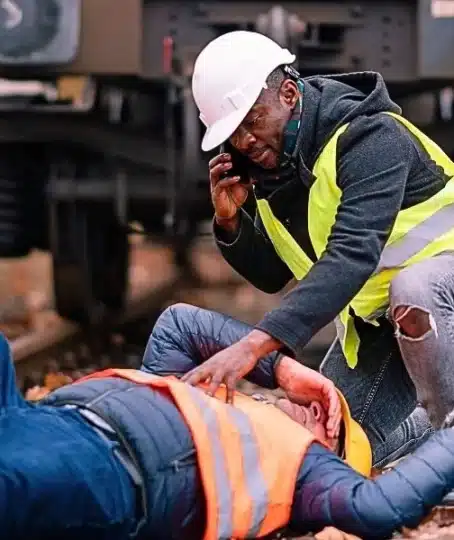
What to Do If You’re Injured in a Car Accident While Working in Illinois Work-related car accidents are common. Between...


Various parties may be liable for railroad crossing accidents, including the railway company that owns and operates the train, a driver, or even the city council. These types of accidents can be particularly dangerous, especially when there are inadequate or defective warning devices in place. When a train and a motor vehicle collide, the outcome can be catastrophic or even fatal. If you have been involved in a railroad crossing accident, you may be eligible to file a lawsuit against the railway company or even the city council to receive compensation.

According to a report by the Federal Highway Administration, out of the 140,000 railway crossings in the United States, 25% of them are unmarked. There may be cases where crossings are not properly protected, or warning signals are not present, leading to accidents that could have been avoided. After such an accident, you may be able to claim compensation via a personal injury claim. Answering, “Will my personal injury case go to trial?” may depend on various factors.
Railroad crossing safety is critical to prevent accidents and fatalities. With over 200,000 miles of track in the United States, it is crucial to be aware of the hazards and take the necessary precautions when driving or walking near railroad tracks.
Every year, crossing and trespassing incidents cause injury or death to more than 2,100 people in the United States, according to a national rail safety organization. More than 60% of train collisions occur at crossings that have lights or gates.
Trains pose unique dangers to cars, making it essential to follow proper railroad safety principles.
Trains are not required to slow down at crossings. The speed of an oncoming train can be difficult to assess. If long trains are moving slower, road users will have to wait longer, leading impatient road users to skip before the train passes.
Estimating the velocity of a train that is coming towards you can be difficult. Your brain has to determine the speed based on the growing size of the front of the train. An approaching train will appear to be closer and traveling faster than what you might perceive.
Modern trains may be fairly quiet. It is essential to listen for the sounds of oncoming trains. Using earphones, loud music, and screaming children can make crossing the railway line more dangerous.
When a train is loaded, it can take more than a mile to come to a complete stop, even if the train's conductor applies the brakes with full force. Furthermore, conductors have limited visibility to the left and right of the tracks, which makes it difficult for them to spot people or objects in their way. In such situations, the train's conductor can only sound the horn and apply the emergency brakes, which can take the train roughly a mile to stop.
Trains may extend a yard or more outside the steel rail, making the safety zone extend well beyond the rails of the train tracks. A safe clearance of 5 yards is prescribed.
Trains cannot swerve to avoid you, and given the weight of a train, the chances of survival in a crash are poor. Airbags will not be able to save you in the event of a collision with a train.
Designated railroad crossings are classified as either private or public. Private crossings, which are located on roads not maintained by public authorities, do not necessarily have advance signs or other markings.
Some railroad crossings have little vehicular and train traffic. At such crossings, it may not be cost-effective to install and maintain gates or flashing lights. The state highway officials make decisions about the appropriate type of warning devices for such crossings.
If you are driving on smaller roads with less traffic in rural areas, you are likely to come across unmarked railroad crossings. Private crossings, which are not maintained by a public authority, are not required to have markings.
In Illinois, a significant number of railroad crossings lack proper warning signals such as crossing arms and flashing lights, which can lead to an increased chance of accidents. Even the crossings with warning systems may be defective due to poor maintenance, faulty products, or other problems, which may result in inadequate warning to drivers of an oncoming train.
If a collision can be attributed to a train conductor or another employee who was not adequately trained, then the railroad company can be held responsible. It is the responsibility of these companies to train and supervise their crew to ensure that they comply with all the applicable laws, rules, and regulations. Furthermore, they are required to maintain crossings to guarantee that they have enough markings and visibility for motorists. A personal injury lawyer can help you to prove negligence by a railroad company.
Drivers can be prone to distractions such as talking or texting on the phone, eating, drinking, conversing with passengers, or adjusting the entertainment, navigation, or stereo system. These distractions can cause drivers to be unaware of a train approaching, which increases the risk of failing to slow down or stop in time to avoid a collision at a railroad crossing.
The responsibility of transforming a crossing from passive to protected typically rests with local government officials. If federal laws require extra warnings and safety measures at a specific crossing, if the crossing is heavily used, or if there have been multiple accidents at a particular crossing with no response from local government, the local government may be at fault for not taking appropriate steps to decrease accidents.
Collisions that occur at train track crossings are complex and often involve both state and federal regulations. Investigating the causes of these accidents requires a thorough examination of the circumstances. In deciding when to hire a personal injury lawyer in Bloomington, the sooner, the better, as he or she can investigate after a railroad crossing accident to determine who can be held liable.
Liability may fall on the railroad company that owns the crossing, particularly if they have not installed and maintained proper lighting and gates or failed to ensure that drivers have clear visibility. The local city may also be held responsible if there is a problem with the design or maintenance of the crossing.
The railroad company has a duty to provide certain safety features to ensure the public safely crosses the railroad tracks at designated crossings. The following safety mechanisms should be in place at these crossings:
Signs and devices alert drivers to the presence of railroad tracks and the chance of a train approaching. They also provide a safety message and remind drivers of the laws regarding highway-rail grade crossings. If necessary, a railroad crossing should have an adequate warning system in place, such as flashing lights, lowering crossing arms, and an audible warning of the approaching train.
The designated crossing area should be free from visual obstructions caused by structures, bushes, trees, weeds, or grass, which may impair the vision of oncoming trains. Maintaining crossing areas in Bloomington is important because motorists should be able to see an approaching train well before reaching the crossing area.
Unfortunately, railroad companies may not always fulfill their duty to the public, leading to accidents where motorists can be injured or killed. If the railroad company fails to provide adequate safety mechanisms, and you are harmed, you may take legal action against the company.
In many cases, the negligence of the driver of the vehicle is a contributing factor in the accident. Trains typically have the right of way because they cannot stop or turn like a vehicle can.
Sometimes, drivers attempt to cross the tracks before the train arrives or park on the tracks while waiting for a red light to turn green, which can result in an accident. Additionally, drivers who are distracted while driving may not be aware of an oncoming train, and this can also be considered negligent and partially at fault for railroad crossing accidents.
State, county, and city officials have the responsibility of deciding whether to install or decommission a railroad crossing or convert a passive one to a protected one or vice versa. Local government is also responsible for creating and enforcing railroad crossing safety regulations.
In the event that the officials do not take the necessary steps to make a railroad crossing safer, the local government entity may be liable in a lawsuit related to the railroad crossing.

What to Do If You’re Injured in a Car Accident While Working in Illinois Work-related car accidents are common. Between...

Why Pedestrian Accidents in Parking Lots Surge During Summer in Illinois As temperatures rise, more individuals tend to engage in...

Drowsy drivers are a serious and often overlooked danger on Illinois roads. Each year, fatigued drivers contribute to thousands of...